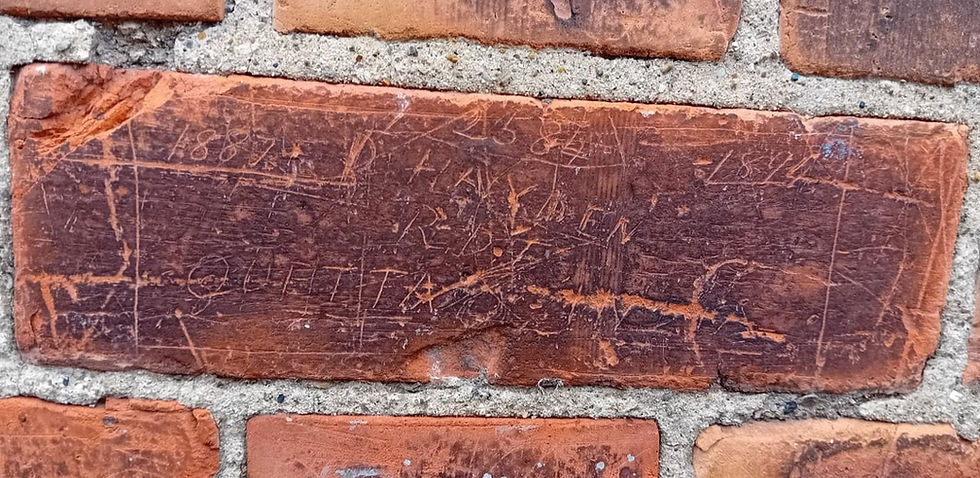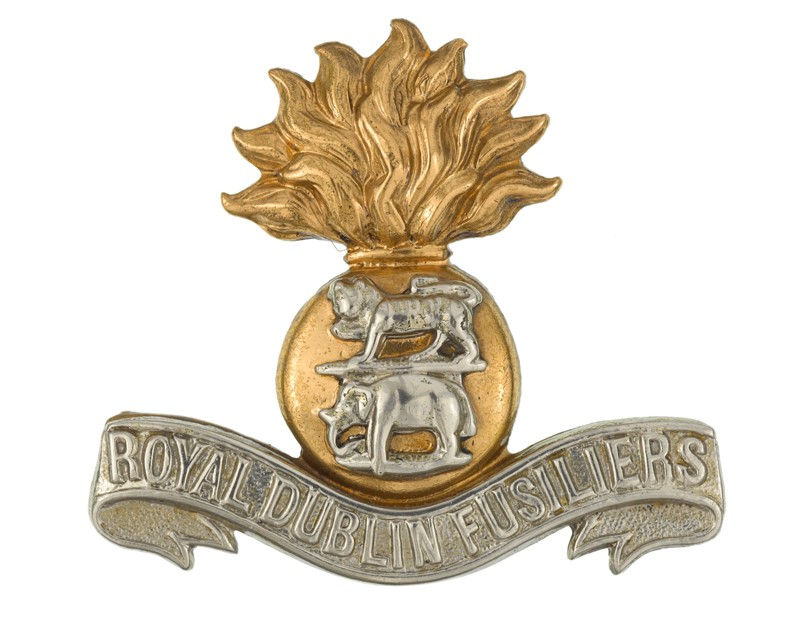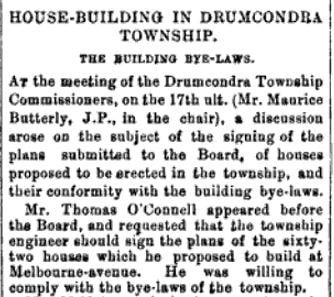A name on a brick - Denis Hayden - a Dublin Soldier's Story
- Stephen Callaghan
- Aug 19
- 5 min read
We pick up regular blog content with an exceptional guest post by Chris Moran. Chris is an easily distracted Drumcondra native, interested in discovering hidden stories and curiosities in his North Dublin neighbourhood.

Do you see it?
1887 2584 1894
D Hayden
R.D.F.
Quetta INDIA
Tracing the path of the former Tolka Mill Race with my daughters - eye-spying graffiti scratched into the brickwork of our 130 year old Drumcondra homes, we recently uncovered the ghost of a Royal Dublin Fusilier - Denis Hayden.

Born on the 6th of April 1868 to Anne Byrne and Mark Hayden of number 10 Bishop Street, Dublin, records show that this labourer's son began service with the Royal Dublin Fusiliers in May 1885 following his 16th birthday.
Hayden, a slight boy of 5 foot 3 inches, weighing only 8 stone at his heaviest, had earlier been rejected as 'unfit for Her Majesty's Service' on the grounds of being, unsurprisingly, underweight. In January of 1887, aged 18, Denis successfully attested with the Royal Irish Fusiliers in Dublin, committing himself for up to 12 years of service.
Described as fresh faced, the dark-haired, blue-eyed youth transferred to the Royal Dublin Fusiliers in May of that same year and was posted to Mullingar, later stationed at the Curragh Camp.
Two years on the 2nd of January 1889, Denis arrived a world away from Bishop’s Street, in Quetta, India (modern day Pakistan), a small frontier town with a British garrison. A place where the British Surgeon General would warn of unsanitary conditions and cholera and historian P.S.A. Berridge called a “forbidding and inhospitable desert and mountainous country.”
The 2nd Battalion, Royal Dublin Fusiliers had left England for Gibraltar in early 1884, and in February 1885 departed for Egypt, quartered at Cairo. Early in 1886 the battalion went to India with headquarters in Quetta.
Following the end of the Second Afghan War, a line to Kandahar was the prize for the British, as a means to deliver troops like our young Dubliner, to the frontier of Afghanistan where continued Russian expansion threatened British interests.
Denis would arrive to see the newly completed railway station, connecting Quetta to the leafy, canal irrigated farmland of Ruk via the Nari Gorge and through the utterly barren, treeless Pat. The British ambition to reach Kandahar via rail, was never fulfilled.
But what did the young Dubliner make of the harsh climate and fearful European mortality Rudyard Kipling sarcastically described as “that very healthy post” [The Story of Uriah]. Was he fascinated or bewildered by the perceived strangeness of the Parsi Tower’s of Silence, Dakhmas, these Zoroastrian funerary structures where the dead were given up to the elements and the vultures?
Of his time in India there is little record. The station hospital in Neemuch however, shows that unlike Kipling’s Jack Barrett who “there gave up the ghost”, Denis survived though not without suffering, contracting Syphilis, Ringworm and severe Pneumonia which left him hospitalised in Hyderabad throughout the winter of 1893.
Denis left Quetta on the SS. Victoria on the 11th of October 1894, returning to Ireland where he transferred to the army reserve, his future uncertain. How different Dublin was from the likes of Pat, where summertime temperatures regularly touched 50 degrees Celsius.
By the mid-1890s, as Denis returned home, Dublin itself was changing. In Drumcondra, cattle dealer turned property developer Thomas O’Connell, now ensconced in the residence that is today the Millmount House pub, pursued his plans with the Drumcondra Township Commissioners to build 62 houses at 'Melbourne Avenue' by the banks of the Tolka.

Here as the century ends, in the employ of O'Connell's fellow northern contractors, McGonagle and Magill, the worldly ex-serviceman Denis Hayden is a labourer once again. And there behind the newly built Tobacco, Spirit, Wine and Beer Merchant, today's Gala, in a moment of remembrance he inscribed his memorial.
Perhaps later, Denis may have attended the homecoming of the 2nd Battalion, Royal Dublin Fusiliers on November 13th, 1903, the “Hardy, wiry warriors” proceeding to Dublin for a public reception at which they would receive their medals at the hands of H.R.H. the Duke of Connaught.
Was Denis Hayden among the throngs of spectators who lined the thoroughfare from the RDS Show-grounds to Pembroke Road on that day?
Of what was in store of the repatriated Denis Hayden we know little. Enough however to surmise that the life to which he returned in Dublin was very hard.
Denis married Mary Smyth with whom he had a daughter, Mary Teresa in 1898. Tragically the child succumbed to the squalor and disease of tenement life in Dublin at the turn of the 20th century, with the Hayden family now residing, as many did, at the South Dublin Union Workhouse. The child Mary Teresa died of tuberculosis in May 1901 and is buried in the Angel’s plot of Glasnevin Cemetery, Dublin.
Denis and Mary, like many Dubliners of the time, grew their families within the workhouse and had another girl, again Mary, in September of 1901.
Spectamur Agendo
Spectamur Agendo reads the regimental motto of the Royal Dublin Fusiliers - ‘Let us be judged by our acts’.
Later Denis is recorded as being sentenced to 5 months hard labour in Mount Joy prison for assault in 1904, released in February of the following year and records show that by 1907 he and Mary are discharged from workhouse after which we know very little about the family.

What we do know, is that while Denis Hayden returned from Quetta in 1894 and where a discreet personal mark to him lay hidden in plain view off Millmount Avenue for over 130 years, another weathered monument stands in the North West corner of Quetta Cemetery by the Old Gate. Erected in memory of the 2nd Battalion Royal Dublin Fusiliers who died during the stay of the regiment in Quetta between 1893 and 1896 and etched with the names of non-commissioned officers, men, women and children, a Private R. Hayden, died 1894, is remembered. Haydens at the edge of an Empire. Two monuments. Two differing fortunes. Denis, remembered while walking in Drumcondra.
The Story of Uriah
"Now there were two men in one city;
the one rich, and the other poor."
Jack Barrett went to Quetta
Because they told him to.
He left his wife at Simla
On three-fourths his monthly screw.
Jack Barrett died at Quetta
Ere the next month's pay he drew.
Jack Barrett went to Quetta.
He didn't understand
The reason of his transfer
From the pleasant mountain-land.
The season was September,
And it killed him out of hand.
Jack Barrett went to Quetta
And there gave up the ghost,
Attempting two men's duty
In that very healthy post;
And Mrs. Barrett mourned for him
Five lively months at most.
Jack Barrett's bones at Quetta
Enjoy profound repose;
But I shouldn't be astonished
If now his spirit knows
The reason of his transfer
From the Himalayan snows.
And, when the Last Great Bugle Call
Adown the Hurnai throbs,
And the last grim joke is entered
In the big black Book of Jobs.
And Quetta graveyards give again
Their victims to the air,
I shouldn't like to be the man
Who sent Jack Barrett there.
Rudyard Kipling
Thanks & Acknowledgements
Quetta – Monuments And Inscriptions by Susan Maria Farrington (1992)
Heritage: Imperial Grit, Spies and Locomotives by Salman Rashid (2020)
Military History research with thanks to Stephen Callaghan
South Dublin Union and Glasnevin research with thanks to Trish Loughman




Comments